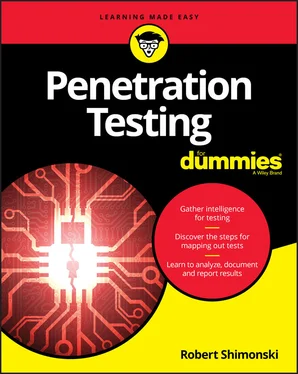4 Chapter 4FIGURE 4-1: Accessing the Kali Linux menu to begin a social engineering attack.FIGURE 4-2: From the Toolkit menu, choose Social-Engineering Attacks.FIGURE 4-3: Choose Website Attack Vectors from this list.FIGURE 4-4: Cloning a site re-creates an exact replica of it.FIGURE 4-5: The options I chose to create a clone website.FIGURE 4-6: I set up a clone Google.com — for pen-testing purposes only!FIGURE 4-7: The different areas of attack vectors.FIGURE 4-8: A password crack via Metasploit.FIGURE 4-9: Using Wireshark to capture and expose data protected by SSL.FIGURE 4-10: Metasploit Pro’s Quick PenTest wizard.FIGURE 4-11: Running a quick pen test with Metasploit Pro.
5 Chapter 5FIGURE 5-1: Using Burp Suite for pen testing.FIGURE 5-2: Viewing an N-tier application.FIGURE 5-3: Using Wireshark to pen test.FIGURE 5-4: Using Wireshark to grab packets in a sniffing operation.FIGURE 5-5: A card skimmer on an ATM.
6 Chapter 6FIGURE 6-1: Using Kali for pen testing disruption attacks.FIGURE 6-2: Launching an attack from outside the network.FIGURE 6-3: Using Kali T50 to send a flood attack to a host.FIGURE 6-4: Viewing resources with the Linux top command.FIGURE 6-5: How a distributed denial of service (DDoS) attack works.FIGURE 6-6: How the buffer overflow attack works.FIGURE 6-7: Use Kali’s fragroute and fragmentation6 to determine your level of ...FIGURE 6-8: Sending malformed packets to hosts with Kali’s fragtest.FIGURE 6-9: Using ping to generate a sweep and smurf attack.FIGURE 6-10: Use Wireshark to identify tiny packet attacks.
7 Chapter 7FIGURE 7-1: Nessus offers various scan types for pen testing destroy attacks.FIGURE 7-2: Looking for hosts that are vulnerable to known threats.FIGURE 7-3: A typical external vector attack with the goal of destroying a data...FIGURE 7-4: An example of a ransomware attack.FIGURE 7-5: An example of AV endpoint protection.
8 Chapter 8FIGURE 8-1: Kali’s Information Gathering menu can help you perform subvert and ...FIGURE 8-2: Using Nmap to launch an attack against a router/routing device scan...FIGURE 8-3: Conducting a SYN scan to identify open ports.FIGURE 8-4: Identifying possible hosts and ports.FIGURE 8-5: Learning the MAC address of the scanned device and distance by netw...FIGURE 8-6: Internal and external subvert attacks operate under the same concep...FIGURE 8-7: Host-based AV software indicates there’s an issue requiring attenti...FIGURE 8-8: Updating and fixing your AV.
9 Chapter 9FIGURE 9-1: Use a RACI chart to identify roles and responsibilities.FIGURE 9-2: Consult past results to help with future tests.FIGURE 9-3: Reviewing threats on the risk register.FIGURE 9-4: Reviewing attack vectors to devise a test plan.FIGURE 9-5: Reviewing Nessus scan templates.FIGURE 9-6: Tuning tools with filters for prep.
10 Chapter 10FIGURE 10-1: Doing a WhoIs search to gain intel.FIGURE 10-2: Pinging at a command prompt to get an IP address or range to scan.FIGURE 10-3: Using Kali (Xhydra) to crack a router password.FIGURE 10-4: A network map with IP addressing.FIGURE 10-5: Building a network map with Nessus.FIGURE 10-6: Building a network map with Nmap.
11 Chapter 11FIGURE 11-1: An example executive summary.FIGURE 11-2: Documenting and reporting attack vectors is part of your narrative...FIGURE 11-3: An example of a Tools, Methods, and Vectors section.FIGURE 11-4: Include your main findings in your report.FIGURE 11-5: An example of a report conclusion.
12 Chapter 12FIGURE 12-1: Reviewing Nessus for hardening tips.FIGURE 12-2: A large network map.FIGURE 12-3: Disabling unneeded services, such as telnet services.FIGURE 12-4: Changing a default port to help secure a system.FIGURE 12-5: Using a firewall allows you to monitor access in and out.FIGURE 12-6: Antivirus software is still an effective way to protect devices fr...FIGURE 12-7: Finding SMB issues on the network with Nessus.FIGURE 12-8: Use encryption such as SSL.FIGURE 12-9: Saving copies of logs in case a hacker interferes.
13 Chapter 13FIGURE 13-1: The pen testing and retesting processes are very similar.FIGURE 13-2: Prioritizing retesting tasks with a tier system.FIGURE 13-3: My updated documentation to reference during the retest.FIGURE 13-4: Using Nessus to find ways to reduce risks in web architecture.FIGURE 13-5: Mapping a network and finding new problems.FIGURE 13-6: Using Nmap to exploit NTP.
14 Chapter 14FIGURE 14-1: A sample metric of cyber threats and their growth. FIGURE 14-2: Wireshark’s bug fix list.FIGURE 14-3: A schedule of tests.
15 Chapter 15FIGURE 15-1: Using Kali and VMware virtualization.FIGURE 15-2: Using a plan B alternative.FIGURE 15-3: Creating a viable lab.
16 Chapter 16FIGURE 16-1: SANS.org.FIGURE 16-2: The GIAC GPEN certification.FIGURE 16-3: The top ten application risks on the Open Web Application Security...FIGURE 16-4: Downloading Nessus.FIGURE 16-5: Gain access to Kali.
1 Cover
2 Table of Contents
3 Begin Reading
1 iii
2 iv
3 1
4 2
5 3
6 5
7 6
8 7
9 8
10 9
11 10
12 11
13 12
14 13
15 14
16 15
17 16
18 17
19 18
20 19
21 20
22 21
23 22
24 23
25 24
26 25
27 26
28 27
29 28
30 29
31 30
32 31
33 32
34 33
35 34
36 35
37 36
38 37
39 38
40 39
41 40
42 41
43 42
44 43
45 44
46 45
47 46
48 47
49 48
50 49
51 50
52 51
53 52
54 53
55 54
56 55
57 56
58 57
59 58
60 59
61 60
62 61
63 62
64 63
65 64
66 65
67 66
68 67
69 69
70 70
71 71
72 72
73 73
74 74
75 75
76 76
77 77
78 78
79 79
80 80
81 81
82 82
83 83
84 84
85 85
86 86
87 87
88 88
89 89
90 90
91 91
92 92
93 93
94 94
95 95
96 96
97 97
98 98
99 99
100 100
101 101
102 102
103 103
104 104
105 105
106 106
107 107
108 108
109 109
110 110
111 111
112 112
113 113
114 114
115 115
116 116
117 117
118 118
119 119
120 120
121 121
122 122
123 123
124 124
125 125
126 126
127 127
128 128
129 129
130 130
131 131
132 132
133 133
134 134
135 135
136 136
137 137
138 138
139 139
140 140
141 141
142 142
143 143
144 144
145 145
146 147
147 148
148 149
149 150
150 151
151 152
152 153
153 154
154 155
155 156
156 157
157 158
158 159
159 161
160 162
161 163
162 164
163 165
164 166
165 167
166 168
167 169
168 170
169 171
170 172
171 173
172 174
173 175
174 176
175 177
176 178
177 179
178 180
179 181
180 182
181 183
182 184
183 185
184 186
185 187
186 188
187 189
188 190
189 191
190 192
191 193
192 194
193 195
194 196
195 197
196 198
197 199
198 200
199 201
200 202
201 203
202 204
203 205
204 206
205 207
206 208
207 209
208 210
209 211
210 212
211 213
212 214
213 215
214 216
215 217
216 218
217 219
218 220
219 221
220 222
221 223
222 224
Читать дальше












